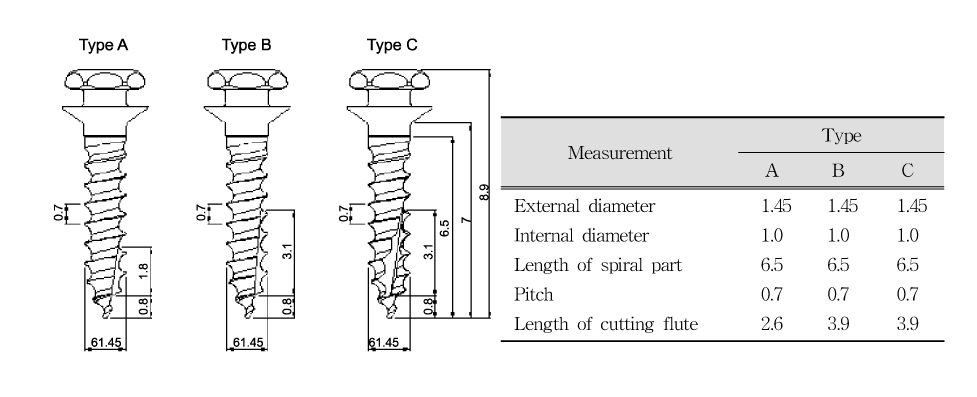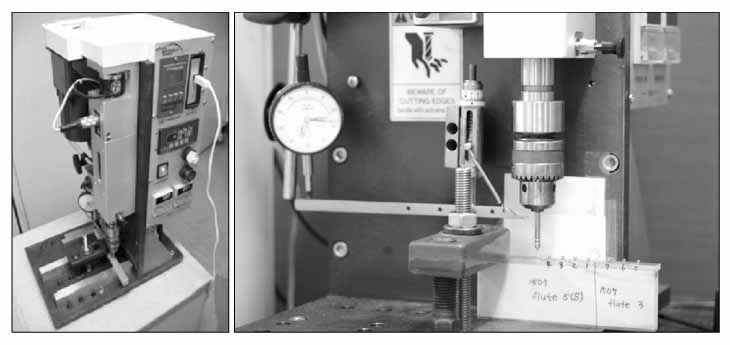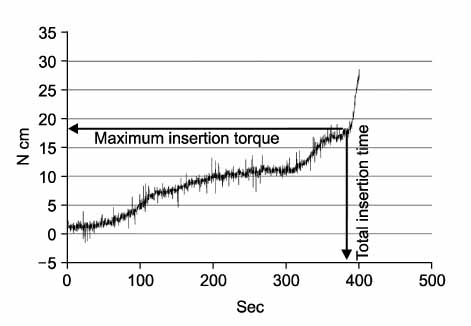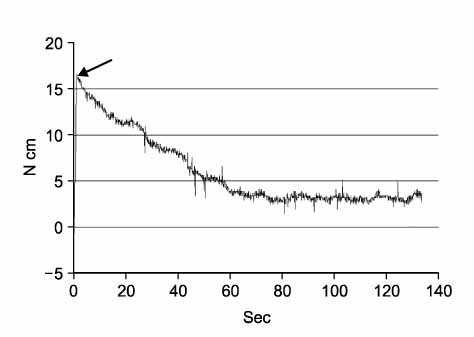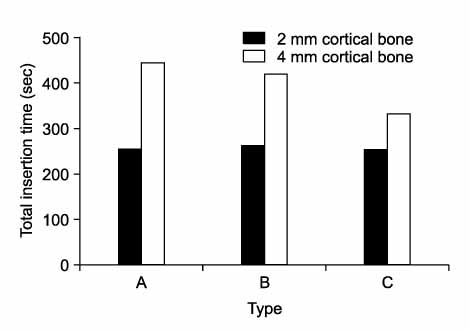Korean J Orthod.
2009 Apr;39(2):95-104. 10.4041/kjod.2009.39.2.95.
Effect of cutting flute length and shape on insertion and removal torque of orthodontic mini-implants
- Affiliations
-
- 1Department of Orthodontics, School of Dentistry, Chosun University, Korea. shlim@chosun.ac.kr
- KMID: 1975814
- DOI: http://doi.org/10.4041/kjod.2009.39.2.95
Abstract
OBJECTIVE
The purpose of this study was to evaluate the effect of length and shape of cutting flute on mechanical properties of orthodontic mini-implants. METHODS: Three types of mini-implants with different flute patterns (Type A with 2.6 mm long flute, Type B with 3.9 mm long and straight flute, Type C with 3.9 mm long and helical flute) were inserted into the biomechanical test blocks (Sawbones Inc., USA) with 2 mm and 4 mm cortical bone thicknesses to test insertion and removal torque. RESULTS: In 4 mm cortical bone thickness, Type C mini-implants showed highest maximum insertion torque, then Type A and Type B in order. Type C also showed shortest total insertion time and highest maximum removal torque, but Type A and B didn't showed statistically significant difference in insertion time and removal torque. In 2 mm cortical bone thickness, there were no significant difference in total insertion time and maximum removal torque in three types of mini-implants, but maximum insertion torque of Type A was higher than two other Types of mini-implants. CONCLUSIONS: Consideration about length and shape of cutting flute of mini-implant is also required when the placement site has thick cortical bone.
MeSH Terms
Figure
Cited by 1 articles
-
The effects of different pilot-drilling methods on the mechanical stability of a mini-implant system at placement and removal: a preliminary study
Il-Sik Cho, HyeRan Choo, Seong-Kyun Kim, Yun-Seob Shin, Duck-Su Kim, Seong-Hun Kim, Kyu-Rhim Chung, John C. Huang
Korean J Orthod. 2011;41(5):354-360. doi: 10.4041/kjod.2011.41.5.354.
Reference
-
1. Kanomi R. Mini-implant for orthodontic anchorage. J Clin Orthod. 1997. 31:763–767.2. Costa A, Raffaini M, Melsen B. Miniscrews as orthodontic anchorage a preliminary report. Int J Adult Orthodon Orthognath Surg. 1998. 13:201–209.3. Park HS. A new proctocol of the sliding mechanics with micro-implant anchorage (MIA). Korean J Orthod. 2000. 30:677–685.4. Park HS. The skeletal cortical anchorage using titanium microscrew implants. Korean J Orthod. 1999. 29:699–706.5. Oh MY, Chung KR, Kwon YD, Ryu DM, Lee BS. The clinical use of miniscrew for intraoral anchorage (1). J Korean Dent Assoc. 2000. 38:18–21.6. Park HS, Jeong SH, Kwon OW. Factors affecting the clinical success of screw implants used as orthodontic anchorage. Am J Orthod Dentofacial Orthop. 2006. 130:18–25.
Article7. Moon CH, Lee DG, Lee HS, Im JS, Baek SH. Factors associated with the success rate of orthodontic miniscrews placed in the upper and lower posterior buccal region. Angle Orthod. 2008. 78:101–106.
Article8. Kuroda S, Sugawara Y, Deguchi T, Kyung HM, Takano-Yamamoto T. Clinical use of miniscrew implants as orthodontic anchorage: success rate and postoperative discomfort. Am J Orthod Dentofacial Orthop. 2007. 131:9–15.
Article9. Cheng SJ, Tseng IY, Lee JJ, Kok SH. A prospective study of the risk factors associated with failure of mini-implants used for orthodontic anchorage. Int J Oral Maxillofac Implants. 2004. 19:100–106.10. Kuroda S, Yamada K, Deguchi T, Hashimoto T, Kyung HM, Takano-Yamamoto T. Root proximity is a major factor for screw failure in orthodontic anchorage. Am J Orthod Dentofacial Orthop. 2007. 131:Suppl 4. 68S–73S.
Article11. You ZH, Bell WH, Schneiderman ED, Ashman RB. Biomechanical properties of small bone screws. J Oral Maxillofac Surg. 1994. 52:1293–1302.
Article12. Kim JW, Cho IS, Lee SJ, Kim TW, Chang YI. Mechanical analysis of the taper shape and length of orthodontic mini-implant for initial stability. Korean J Orthod. 2006. 36:55–62.13. Kim JW, Cho IS, Lee SJ, Kim TW, Chang YI. Effect of dual pitch mini-implant design and diameter of an orthodontic mini-implant on the insertion and removal torque. Korean J Orthod. 2006. 36:275–283.14. Yano S, Motoyoshi M, Uemura M, Ono A, Shimizu N. Tapered orthodontic miniscrews induce bone-screw cohesion following immediate loading. Euro J Orthod. 2006. 28:541–546.
Article15. Song YY, Cha JY, Hwang CJ. Evaluation of insertion torque and pull-out strength of mini-screws according to different thickness of artificial cortical bone. Korean J Orthod. 2007. 37:5–15.16. Lim SA, Cha JY, Hwang CJ. Insertion torque of orthodontic miniscrews according to changes in shape, diameter and length. Angle Orthod. 2008. 78:234–240.
Article17. Heidemann W, Gerlach KL, Gröbel KH, Köllner HG. Drill free screws: a new form of osteosynthesis screw. J Craniomaxillofac Surg. 1998. 26:163–168.
Article18. Heidemann W, Gerlach KL, Grobel KH, Kollner HG. Influence of different pilot hole sizes on torque measurements and pullout analysis of osteosynthesis screws. J Craniomaxillofac Surg. 1998. 26:50–55.
Article19. Kim JW, Ahn SJ, Chang YI. Histomorphometric and mechanical analysis of the drill-free screw as orthodontic anchorage. Am J Orthod Dentofacial Orthop. 2005. 128:190–194.
Article20. Kim JW, Chang YI. Effect of drilling process in stability of micro-implants used for orthodontic anchorage. Korean J Orthod. 2002. 32:107–115.21. Kim YH, Choi JH. The study about retention of miniscrews used for intraoral anchorage. J Korean Dent Assoc. 2001. 39:684–687.22. Ansell RH, Scales JT. A study of some factors which affect the strength of screws and their insertion and holding power in bone. J Biomech. 1968. 1:279–302.
Article23. Foley WL, Frost DE, Paulin WB Jr, Tucker MR. Uniaxial pullout evaluation of internal screw fixation. J Oral Maxillofac Surg. 1989. 47:277–280.
Article24. Evans M, Spencer M, Wang Q, White SH, Cunningham JL. Design and testing of external fixator bone screws. J Biomed Eng. 1990. 12:457–462.
Article25. Yerby S, Scott CC, Evans NJ, Messing KL, Carter DR. Effect of cutting flute design on cortical bone screw insertion torque and pullout strength. J Orthop Trauma. 2001. 15:216–221.
Article26. Wikenheiser MA, Markel MD, Lewallen DG, Chao EYS. Thermal response and torque resistance of five cortical half-pins under simulated insertion technique. J Orthop Res. 1665. 13:615–619.
Article27. Koistinen A, Santavirta SS, Kröger H, Lappalainen R. Effect of bone mineral density and amorphous diamond coatings on insertion torque of bone screws. Biomaterials. 2005. 26:5687–5694.
Article28. Seebeck J, Goldhahn J, Städele H, Messer P, Morlock MM, Schneider E. Effect of cortical thickness and cancellous bone density on the holding strength of internal fixator screws. J Orthop Res. 2004. 22:1237–1242.
Article29. Deguchi T, Nasu M, Murakami K, Yabuuchi T, Kamioka H, Takano-Yamamoto T. Quantitative evaluation of cortical bone thickness with computed tomographic scanning for orthodontic implants. Am J Orthod Dentofacial Orthop. 2006. 129:721.e7–721.e12.
Article30. Liou EJW, Chen PH, Wang YC, Lin JC. A computed tomographic image study on the thickness of the infrazygomatic crest of the maxilla and its clinical implications for miniscrew insertion. Am J Orthod Dentofacial Orthop. 2007. 131:352–356.
Article31. Motoyoshi M, Hirabayashi M, Uemura M, Shimizu N. Recommended placement torque when tightening an orthodontic mini-implant. Clin Oral Implants Res. 2006. 17:109–114.
Article
- Full Text Links
- Actions
-
Cited
- CITED
-
- Close
- Share
- Similar articles
-
- Mechanical analysis of the taper shape and length of orthodontic mini-implant for initial stability
- Effect of dual pitch mini-implant design and diameter of an orthodontic mini-implant on the insertion and removal torque
- Geometrical design characteristics of orthodontic mini-implants predicting maximum insertion torque
- Influence of surface treatment on the insertion pattern of self-drilling orthodontic mini-implants
- Bone cutting capacity and osseointegration of surface-treated orthodontic mini-implants

